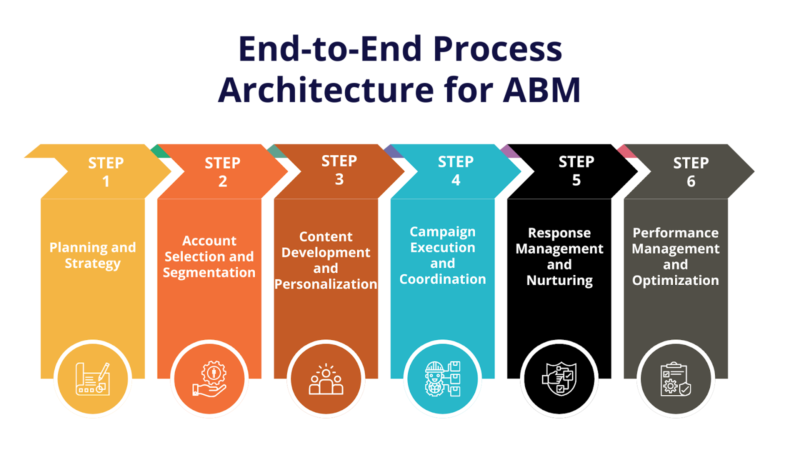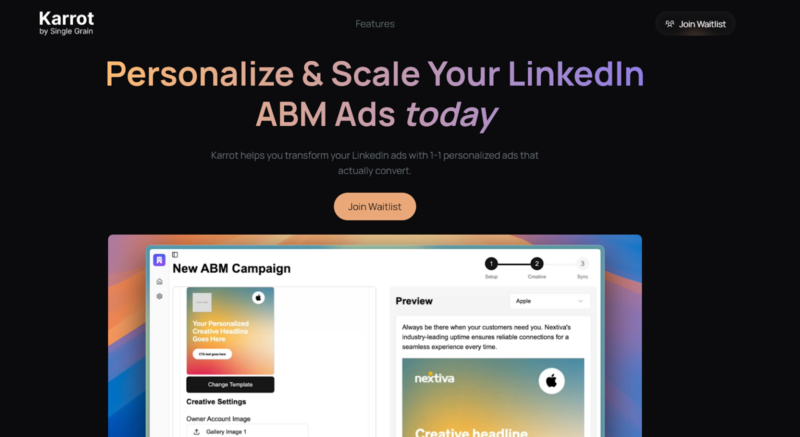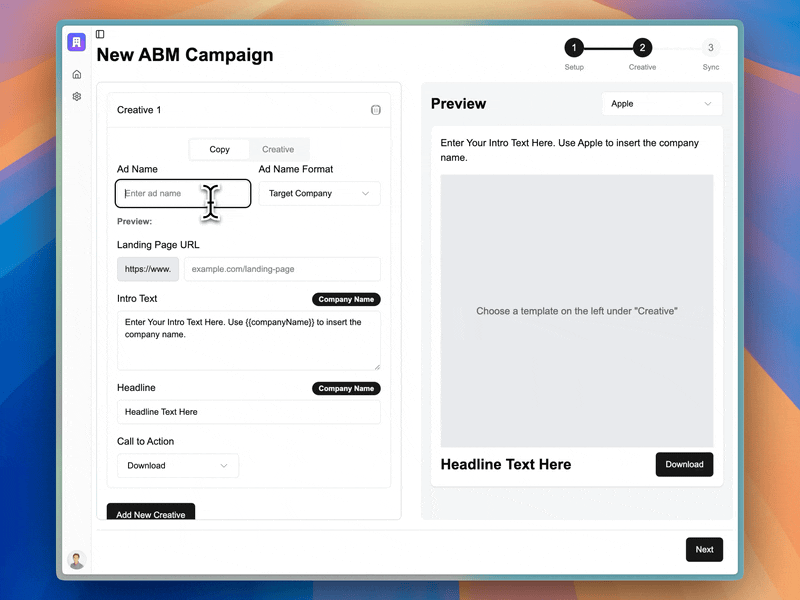Account-based marketing (ABM) combines efficiency, consistency, and creativity. However, it can be overwhelming to execute, given the demands of a multi-channel campaign and hyper-personalized content creation.
While many marketers focus on campaign concepts and content, the operational backbone of ABM—workflows, integrations, and automation—often determines whether campaigns achieve their full potential or fall short of expectations.
This guide is about enhancing your ABM workflow, and it includes our AI tool recommendations for integrating into your LinkedIn pipeline.
Key Highlights
- Automated ABM workflows can improve campaign execution efficiency by up to 67% while reducing errors by 85%
- 97% of marketers report that ABM delivers a higher return on investment than other marketing strategies
- Integration between LinkedIn and CRM systems enables 42% higher conversion rates through improved lead management
- Workflow standardization ensures consistent execution across campaigns and teams
- Trigger-based automation allows timely responses to account behaviors and signals
- AI-powered tools like Karrot.ai can automate complex personalization and optimization processes
- End-to-end measurement connects LinkedIn activities to pipeline and revenue outcomes
- Scalable frameworks enable program expansion without proportional resource increases
TABLE OF CONTENTS:
Workflows for LinkedIn ABM
87% of marketers say ABM generates better results than other strategies. Unfortunately, marketers also struggle to achieve a satisfying ROI.
That’s because ABM is very complex. Targeting dozens or hundreds of accounts with personalized experiences creates significant workflow challenges. Fortunately, there are many ways to work through them.
Challenges with ABM Operations
LinkedIn ABM programs face several operational challenges. Marketers must have the right research, budget, data, and technology to execute an ABM campaign. Other issues, such as other marketing investments and the competition, can also come into play. Here are some of the key challenges that marketers may experience when starting ABM:
- Scale requirements: Managing campaigns across numerous target accounts.
- Personalization demands: Creating and delivering customized content.
- Cross-functional coordination: Aligning marketing, sales, and other teams.
- Multi-channel orchestration: Coordinating LinkedIn with other touchpoints.
- Data management complexity: Handling information across systems.
- Performance tracking requirements: Measuring results across accounts and activities.
This explains why many ABM programs struggle to achieve their potential.
The ABM Workflow Framework
Effective LinkedIn ABM requires a structured workflow framework. Here are the best practices to remember.
End-to-End Process Architecture

Implement a comprehensive workflow approach, such as:
– Planning and Strategy
– Account Selection and Segmentation
– Content Development and Personalization
– Campaign Execution and Coordination
– Response Management and Nurturing
– Performance Measurement and Optimization
This end-to-end framework ensures all aspects of the ABM process are addressed rather than focusing solely on execution.
Technology Integrations
The right tools are critical in executing an ABM campaign. Marketers may use standard tools, including AI and automation, a CRM, and data analytics. Develop an integrated technology ecosystem, such as this one:
| System Category | Examples | Integration Points |
|---|---|---|
| CRM | Salesforce, HubSpot | Account data, opportunity tracking |
| Marketing Automation | Marketo, Eloqua, HubSpot | Lead management, nurture flows |
| ABM Platforms | Demandbase, 6sense, Terminus | Account insights, orchestration |
| LinkedIn Advertising | Campaign Manager, Sales Navigator | Campaign execution, engagement |
| Content Management | CMS, DAM, Seismic | Asset creation and distribution |
| Analytics | BI tools, attribution platforms | Performance measurement |
This integrated ecosystem ensures data flows seamlessly across systems rather than remaining trapped in silos.
Strategy 1: Implement Account Data Integration
Data integration is the foundation of effective ABM workflows. Here’s some advice for an effective data management strategy.
CRM-LinkedIn Synchronization
Here are ways to establish data flow between systems:
- Account list synchronization: Automated target account updates.
- Contact data integration: Stakeholder information sharing.
- Engagement data transfer: Activity tracking across platforms.
- Opportunity stage synchronization: To create a more cohesive sales pipeline.
- Relationship data sharing: Connection and interaction history.
This integration ensures LinkedIn campaigns operate with accurate account information while data benefits sales activities.
Unified Account Profiles
Create comprehensive account views using these steps:
- Firmographic data aggregation: Company information from multiple sources.
- Stakeholder mapping: Complete view of relevant contacts.
- Engagement history compilation: Interactions across all touchpoints.
- Intent signal integration: Buying indicators from various platforms.
- Relationship status tracking: Current state of account connections.
This unified view ensures all teams work together rather than from fragmented perspectives.
Automated Data Maintenance
Data cleansing ensures you’re only working with accurate and relevant account information. Implement systematic data maintenance in these ways:
- Regular data validation: Verification of account information.
- Automated enrichment: Supplementing profiles with additional data.
- Duplicate management: Preventing redundant records.
- Change detection: Identifying and updating modified information.
- Data governance enforcement: Maintaining consistent standards.
This data automation ensures decisions are based on accurate information rather than outdated or incorrect data.
Strategy 2: Create Standardized Campaign Workflows
Workflow standardization improves consistency and efficiency in many ways. Here are a few examples.
Campaign Process Templates
Develop standardized workflows for different campaign types, such as this one for new account acquisition:
- Account selection and prioritization
- Stakeholder identification and research
- Personalized content development
- LinkedIn campaign setup and targeting
- Sales outreach coordination
- Engagement tracking and follow-up
- Performance measurement and reporting
These templated processes ensure campaigns follow proven approaches rather than reinventing workflows for each initiative.
Task Automation Implementation
Automation can streamline your ABM campaign by completing repetitive and redundant tasks. Here are routine tasks that marketers can automate:
- Campaign setup automation: Templated campaign creation.
- Audience building: Automated list generation and targeting.
- Creative assembly: Templated content production.
- Approval workflows: Streamlined review processes.
- Performance reporting: Automated data compilation and distribution.
Robotic process automation (RPA) reduces manual effort by 50-70%, improving consistency and reducing errors.
The Karrot.ai Workflow Advantage

Platforms like Karrot.ai enhance workflow efficiency through:
- AI-powered campaign setup that streamlines targeting and creative development.
- Automated personalization that eliminates manual content customization.
- Performance optimization that continuously refines campaigns.
- Cross-channel coordination that synchronizes LinkedIn with other touchpoints.
- Insight generation that identifies opportunities for improvement.
This AI-enhanced approach enables sophisticated campaign execution without wasting time and resources.
Strategy 3: Implement Trigger-Based Automation
Automated responses to account behaviors significantly improve your ABM campaign. Here’s how to use trigger automation across all your channels.
Behavioral Trigger Framework
Behavioral targeting is crucial to targeting accounts and personalizing messaging. But you won’t know if you’re maximizing ROI or driving engagements without the right behavioral triggers. Develop a comprehensive trigger system using a strategy like this one:
| Trigger Category | Examples | Automated Response |
|---|---|---|
| Engagement Triggers | Content interaction, ad clicks | Follow-up content delivery |
| Intent Triggers | Research activity, competitor comparison | Sales alert, targeted messaging |
| Stage Triggers | Opportunity creation, pipeline advancement | Stage-appropriate content |
| Timing Triggers | Contract renewal dates, fiscal periods | Timely outreach campaigns |
| Event Triggers | Leadership changes, funding rounds | Congratulatory outreach |
This trigger framework ensures accounts receive timely, relevant responses rather than generic scheduled communications.
Multi-Step Automation Sequences
Implement sophisticated response flows using these methods:
- Trigger identification: Detecting relevant account behaviors.
- Context evaluation: Assessing the broader account situation.
- Response selection: Determining appropriate following actions.
- Channel coordination: Activating the right touchpoints.
- Timing optimization: Delivering at the optimal moment.
- Performance tracking: Measuring response effectiveness.
These multi-dimensional sequences ensure automated responses consider the complete account context rather than reacting to isolated signals.
Sales-Marketing Coordination Automation
Automation can combine sales and marketing tactics into one workflow. This increases efficiency when finding, engaging, and converting accounts. Streamline cross-team collaboration using these strategies:
- Automated sales alerts: Notifications about significant account activities.
- Task creation: Assigning appropriate follow-up actions.
- Content recommendations: Suggesting relevant materials for outreach.
- Meeting scheduling: Facilitating connections with interested accounts.
- Feedback collection: Gathering sales insights about account interactions.
This coordination automation ensures marketing activities seamlessly connect with sales, creating a consistent account experience.
Strategy 4: Develop Content Workflow Automation
Content production often becomes a bottleneck in ABM execution. Here’s how to automate your content processes to target high-value accounts better.
Content Production Workflows
Implement streamlined content development processes, such as this one for a personalized content workflow:
- Template selection from content library.
- Account data integration for personalization.
- Dynamic element customization.
- Automated quality assurance.
- Approval routing and tracking.
- Asset preparation for various channels.
- Performance tagging for measurement.
Dynamic Content Assembly
You can automate personalized content creation using these methods:
- Template-based generation: Content creation from standard formats.
- Rules-based personalization: Systematic customization based on account attributes.
- Dynamic element insertion: Automated inclusion of account-specific information.
- Format adaptation: Automatic adjustment for different channels.
- Version control: Systematic management of content variations.
Automated content creation can boost personalization at scale without additional resources.
Content Performance Automation
Marketers can use intent data to optimize content performance. Here’s how it can be done:
- Performance tracking: Monitoring content effectiveness.
- Pattern identification: Recognizing successful approaches.
- Automated testing: Comparing different content variations.
- Insight application: Implementing learnings across assets.
- Content refreshment: Updating materials based on performance.
This ensures content continuously improves rather than remaining static.
Strategy 5: Create Integrated Measurement Workflows
To understand true campaign impact, all marketers must track vital metrics. Here’s how to do this while maintaining integrated workflows.
Cross-Platform Attribution
ABM marketers can follow the customer journey across multiple platforms. Implement comprehensive attribution processes in these ways:
- LinkedIn activity tracking: Monitoring engagement across ad formats.
- Website integration: Connecting LinkedIn traffic to site behavior.
- CRM opportunity linking: Associating campaigns with pipeline.
- Revenue attribution: Connecting activities to closed business.
- Multi-touch modeling: Distributing credit across touchpoints.
This integrated attribution ensures that the impact of LinkedIn ABM is properly valued rather than underestimated due to measurement gaps.
Automated Reporting Workflows
Streamline performance communication using these methods:
- Data aggregation: Combining metrics from multiple sources.
- Automated calculation: Computing derived metrics and KPIs.
- Visualization generation: Creating standardized charts and graphs.
- Report distribution: Delivering insights to stakeholders.
- Interactive exploration: Enabling deeper analysis as needed.
This reduces manual effort while ensuring consistent performance across your workflows.
Closed-Loop Optimization
Closed-loop marketing is the continuous flow of highly tailored experiences to engage accounts and drive conversions. Here’s how to implement systematic processes for closed-loop marketing:
- Performance anomaly detection: Identifying unexpected results.
- Root cause analysis: Determining factors driving outcomes.
- Opportunity identification: Recognizing improvement potential.
- Test implementation: Executing controlled experiments.
- Learning application: Implementing successful approaches.
This closed-loop approach drives continuous improvements for your ABM campaign.
Strategy 6: Scale Through Workflow Frameworks
Scalable frameworks enable program growth without increasing unnecessary resources. Here are ways to implement these frameworks in your campaign.
Tiered Execution Models
Tiered ABM is organizing accounts into different groups. Marketers can include this process in their workflows to optimize resources and maximize impact. Here are examples of tiered ABM.
Tier 1 (Strategic Accounts)
- Highly customized workflows
- Significant manual touchpoints
- Deep personalization
- Extensive sales coordination
Tier 2 (Target Accounts)
- Semi-automated workflows
- Templated personalization
- Selective manual interventions
- Structured sales coordination
Tier 3 (Scale Accounts)
- Fully automated workflows
- Rules-based personalization
- Exception-based manual involvement
- Automated sales alerts
This tiered approach ensures marketers use resources according to account value while targeting the entire target list.
Center of Excellence Model
Use these methods to establish a centralized workflow management function that aligns your marketing efforts:
- Process development: Creating standardized workflows.
- Technology management: Maintaining integrated systems.
- Best practice documentation: Capturing proven approaches.
- Training and enablement: Building team capabilities.
- Performance monitoring: Ensuring workflow effectiveness.
This approach ensures consistency and efficiency while adapting to specific market needs.
Continuous Improvement Framework
ABM marketers should continue reviewing their workflows to ensure they align with their goals. Here are ways to enhance your existing framework:
- Regular workflow assessment: Evaluating current processes.
- Efficiency analysis: Identifying bottlenecks and constraints.
- Automation opportunity identification: Finding manual tasks to streamline.
- Integration gap detection: Locating disconnected systems.
- Enhancement implementation: Deploying workflow improvements.
This ensures workflows continuously evolve rather than remaining static as ABM requirements and capabilities change.
Case Study: Technology Company Transforms ABM Through Workflow Enhancement
A B2B technology company faced significant challenges scaling its LinkedIn ABM program from 50 to 500 target accounts. By implementing comprehensive workflow automation and integration, they:
- Established data flow between LinkedIn, their CRM, and marketing automation platform.
- Created standardized campaign workflows for different account segments and campaign types.
- Implemented trigger-based automation for timely response to account behaviors.
- Developed content workflow automation that reduced production time by 65%.
- Created integrated measurement processes that connected LinkedIn activities to revenue.
- Established a center of excellence to manage and continuously improve workflows.
The results demonstrated the power of workflow enhancement:
- 67% reduction in campaign setup and execution time
- 85% decrease in execution errors and inconsistencies
- 42% improvement in lead management efficiency
- 3.2X increase in personalized content production capacity
- $18.4M in attributed pipeline from LinkedIn campaigns
- 78% of marketing team time shifted from manual tasks to strategic activities
Best Practices for ABM Workflow Success
While these templates can help you get started, creating a workflow that aligns with your unique objectives and can better target your accounts is still best. Start by following these proven best practices:
- Start with process mapping to understand current workflows before automation
- Implement integration before automation to ensure data flows properly
- Adopt a phased approach rather than attempting complete transformation at once
- Balance automation with human judgment for optimal results
- Document workflows thoroughly to ensure consistent execution
- Train teams on both process and technology to build necessary capabilities
- Measure workflow efficiency alongside campaign performance
- Create feedback mechanisms to identify improvement opportunities
- Leverage AI-powered tools like Karrot.ai to enhance automation capabilities
- Continuously refine workflows based on changing requirements and capabilities
Enhancing ABM Workflows Will Make Your Campaign More Effective
ABM workflows are designed to increase efficiency and consistency. Marketers can achieve this by implementing sophisticated operational approaches, from data integration and standardized workflows to trigger-based automation and scalable frameworks.
How can ABM marketers integrate their workflows with LinkedIn and other existing technologies? Implement data integration, use templates, automate processes, scale content, integrate all channels, and use tiered ABM.
Tools like Karrot.ai can help you achieve personalization and optimization without wasting time and resources. When you create efficient workflows, you create ABM programs that deliver exceptional, scalable results for your business.




